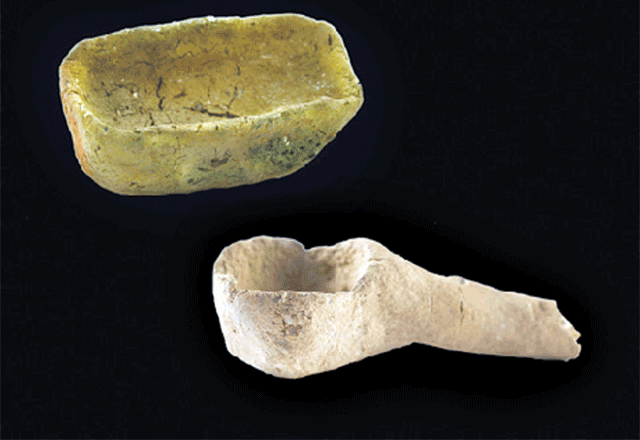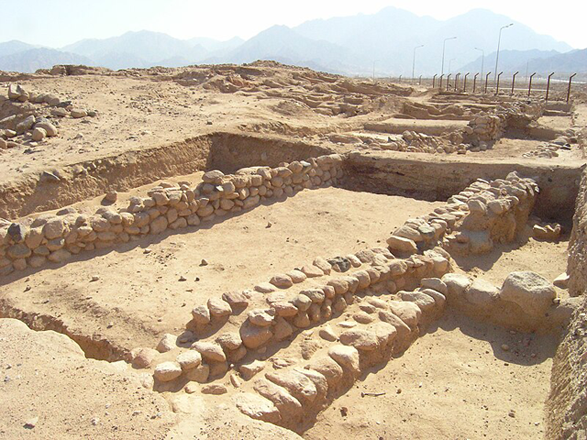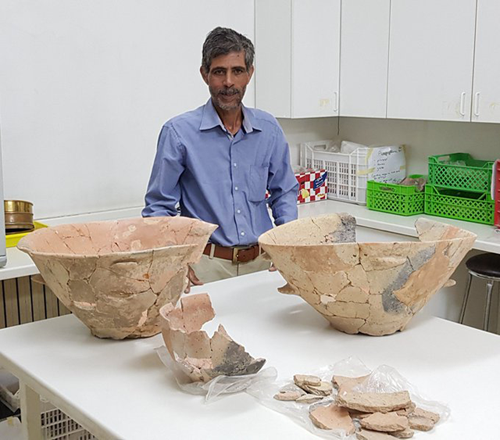You are here
Danish archaeologist examines pottery from Jordan’s Hujayrat Al Ghuzlan
By Saeb Rawashdeh - Mar 22,2023 - Last updated at Mar 23,2023

Pottery found at Tall Hujayrat Al Ghuzlan (Photo courtesyof N. Becker)
AMMAN — Pottery found in Hujayrat Al Ghuzlan, a site located four kilometres north of Aqaba, dates back to between 4,000 and 3,400 BC, according to a Danish archaeology professor.
The architecture at Hujayrat Al Ghuzlan consists of stone boulder walls as well as mudbrick walls, and sometimes a combination of both, noted professor Susanne Kerner, adding that the site was surrounded by a large stone wall, which might have been built to secure the settlement against flooding and other elements.
“The site was only inhabited during several hundreds of years and was destroyed by two consecutive earthquakes shortly following each other in the 4th millennium BC, noted Kerner.
The Hujayrat Al Ghuzlan pottery is characterised by its low quality, both in terms of shaping and firing, Kerner said, adding that the material is so coarse and so lowly fired that it crumbles easily.
“Fingerprints all over the vessels show how carelessly the finishing was carried out. Other signs of technical deficiency are the large number of vessels, which are not symmetrically formed; so they either were shaped by a not very talented potter or changed shape during the drying process and became loop-sided thus confirming the low technological standard,” she said.
Furthermore, the only sign of technical improvement might be the high percentage of mat impressions on the bases of the vessels; roughly one third showed these impressions, Kerner continued, adding that most of these mat impressions come from round mats and show that the vessels would have stood in the middle of the mats, suggesting these could have been used as turning devices.
“The pottery from Hujayrat Al Ghuzlan contains very large V-shaped bowls often with ledge handles. Some bowls have a spout, which in that particular form is not known from Chalcolithic material. Hole-mouth-jars are also very common and exist in a smaller and a larger version, the latter in the size of storage vessels,” Kerner outlined.
However, the only better made ware needs to be mentioned in particular as it might show interesting connections to Egypt: The small jars of type are made from a much finer, reddish fabric that shows a high content of limestone.
“This fabric is not compatible to the rest of the ceramics in the site, but stands in a line of development from the earlier high fired, red, hardware to the much later red ware with lime inclusions found in its latest appearance in the Abydos tombs [in Egypt] of the later Early Bronze Age,” Kerner said.
There, some 500 wine vessels have been found in a tomb dating to 3,320 BC.
“The fabric is similar to the material from Hujayrat Al Ghuzlan, the shape is compatible, but the vessels found in Egypt are much larger,” the archaeologist concluded.
Related Articles
AMMAN — Jabel Mutawwaq is a site near Zarqa River with pottery finds that are older than the Bronze Age.
AMMAN — Located in northern Jordan, Basatin is a site where around 900 shreds were diagnosed from the Late Neolithic.
AMMAN — Murayghat is a Prehistoric site located 3km southwest from Madaba known for the large number of dolmens scattered on its slopes.

















